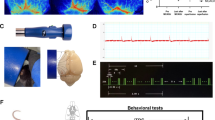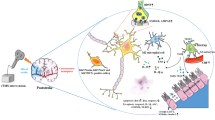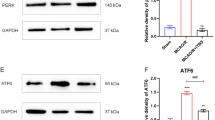Abstract
Recent work suggests that repetitive transcranial magnetic stimulation (rTMS) may beneficially alter the pathological status of several neurological disorders, although the mechanism remains unclear. The current study was designed to investigate the effects of rTMS on behavioral deficits and potential underlying mechanisms in a rat photothrombotic (PT) stroke model. From day 0 (3 h) to day 5 after the establishment of PT stroke, 5-min daily continuous theta-burst rTMS (3 pulses of 50 Hz repeated every 200 ms, intensity at 200 G) was applied on the infarct hemisphere. We report that rTMS significantly attenuated behavioral deficits and infarct volume after PT stroke. Further investigation demonstrated that rTMS remarkably reduced synaptic loss and neuronal degeneration in the peri-infarct cortical region. Mechanistic studies displayed that beneficial effects of rTMS were associated with robust suppression of reactive micro/astrogliosis and the overproduction of pro-inflammatory cytokines, as well as oxidative stress and oxidative neuronal damage especially at the late stage following PT stroke. Intriguingly, rTMS could effectively induce a shift in microglial M1/M2 phenotype activation and an A1 to A2 switch in astrocytic phenotypes. In addition, the release of anti-inflammatory cytokines and mitochondrial MnSOD in peri-infarct regions were elevated following rTMS treatment. Finally, rTMS treatment efficaciously preserved mitochondrial membrane integrity and suppressed the intrinsic mitochondrial caspase-9/3 apoptotic pathway within the peri-infarct cortex. Our novel findings indicate that rTMS treatment exerted robust neuroprotection when applied at least 3 h after ischemic stroke. The underlying mechanisms are partially associated with improvement of the local neuronal microenvironment by altering inflammatory and oxidative status and preserving mitochondrial integrity in the peri-infarct zone. These findings provide strong support for the promising therapeutic effect of rTMS against ischemic neuronal injury and functional deficits following stroke.








Similar content being viewed by others
References
Benjamin EJ, Muntner P, Alonso A, Bittencourt MS, Callaway CW, Carson AP, et al. Heart disease and stroke statistics-2019 update: a report from the American Heart Association. Circulation. 2019;139(10):e56–e528. https://doi.org/10.1161/CIR.0000000000000659.
Kirmani JF, Alkawi A, Panezai S, Gizzi M. Advances in thrombolytics for treatment of acute ischemic stroke. Neurology. 2012;79(13 Suppl 1):S119–25. https://doi.org/10.1212/WNL.0b013e3182695882.
Derex L, Cho TH. Mechanical thrombectomy in acute ischemic stroke. Rev Neurol (Paris). 2017;173(3):106–13. https://doi.org/10.1016/j.neurol.2016.06.008.
Akbar M, Essa MM, Daradkeh G, Abdelmegeed MA, Choi Y, Mahmood L, et al. Mitochondrial dysfunction and cell death in neurodegenerative diseases through nitroxidative stress. Brain Res. 2016;1637:34–55. https://doi.org/10.1016/j.brainres.2016.02.016.
Ferrer I. Apoptosis: future targets for neuroprotective strategies. Cerebrovasc Dis. 2006;21(Suppl 2):9–20. https://doi.org/10.1159/000091699.
Pekny M, Wilhelmsson U, Tatlisumak T, Pekna M. Astrocyte activation and reactive gliosis-a new target in stroke? Neurosci Lett. 2019;689:45–55. https://doi.org/10.1016/j.neulet.2018.07.021.
Shu L, Chen B, Chen B, Xu H, Wang G, Huang Y, et al. Brain ischemic insult induces cofilin rod formation leading to synaptic dysfunction in neurons. J Cereb Blood Flow Metab. 2018;2018:271678X18785567. https://doi.org/10.1177/0271678X18785567.
Hofmeijer J, van Putten MJ. Ischemic cerebral damage: an appraisal of synaptic failure. Stroke. 2012;43(2):607–15. https://doi.org/10.1161/STROKEAHA.111.632943.
Andrabi SS, Parvez S, Tabassum H. Progesterone induces neuroprotection following reperfusion-promoted mitochondrial dysfunction after focal cerebral ischemia in rats. Dis Model Mech. 2017;10(6):787–96. https://doi.org/10.1242/dmm.025692.
Wang LL, Li J, Gu X, Wei L, Yu SP. Delayed treatment of 6-Bromoindirubin-3′-oxime stimulates neurogenesis and functional recovery after focal ischemic stroke in mice. Int J Dev Neurosci. 2017;57:77–84. https://doi.org/10.1016/j.ijdevneu.2017.01.002.
Ahmed ME, Tucker D, Dong Y, Lu Y, Zhao N, Wang R, et al. Methylene Blue promotes cortical neurogenesis and ameliorates behavioral deficit after photothrombotic stroke in rats. Neuroscience. 2016;336:39–48. https://doi.org/10.1016/j.neuroscience.2016.08.036.
Yang L, Tucker D, Dong Y, Wu C, Lu Y, Li Y, et al. Photobiomodulation therapy promotes neurogenesis by improving post-stroke local microenvironment and stimulating neuroprogenitor cells. Exp Neurol. 2018;299(Pt A:86–96. https://doi.org/10.1016/j.expneurol.2017.10.013.
Giannakopoulou A, Lyras GA, Grigoriadis N. Long-term effects of autoimmune CNS inflammation on adult hippocampal neurogenesis. J Neurosci Res. 2017;95(7):1446–58. https://doi.org/10.1002/jnr.23982.
Hamblin MR. Mechanisms and applications of the anti-inflammatory effects of photobiomodulation. AIMS Biophys. 2017;4(3):337–61. https://doi.org/10.3934/biophy.2017.3.337.
Gulke E, Gelderblom M, Magnus T. Danger signals in stroke and their role on microglia activation after ischemia. Ther Adv Neurol Disord. 2018;11:1756286418774254. https://doi.org/10.1177/1756286418774254.
Dheen ST, Kaur C, Ling EA. Microglial activation and its implications in the brain diseases. Curr Med Chem. 2007;14(11):1189–97.
Zhao SC, Ma LS, Chu ZH, Xu H, Wu WQ, Liu F. Regulation of microglial activation in stroke. Acta Pharmacol Sin. 2017;38(4):445–58. https://doi.org/10.1038/aps.2016.162.
Liu R, Liao XY, Tang JC, Pan MX, Chen SF, Lu PX, et al. BpV(pic) confers neuroprotection by inhibiting M1 microglial polarization and MCP-1 expression in rat traumatic brain injury. Mol Immunol. 2019;112:30–9. https://doi.org/10.1016/j.molimm.2019.04.010.
Li Q, Dai Z, Cao Y, Wang L. Caspase-1 inhibition mediates neuroprotection in experimental stroke by polarizing M2 microglia/macrophage and suppressing NF-kappaB activation. Biochem Biophys Res Commun. 2019;513(2):479–85. https://doi.org/10.1016/j.bbrc.2019.03.202.
Liddelow SA, Guttenplan KA, Clarke LE, Bennett FC, Bohlen CJ, Schirmer L, et al. Neurotoxic reactive astrocytes are induced by activated microglia. Nature. 2017;541(7638):481–7. https://doi.org/10.1038/nature21029.
Huang L, Wu ZB, Zhuge Q, Zheng W, Shao B, Wang B, et al. Glial scar formation occurs in the human brain after ischemic stroke. Int J Med Sci. 2014;11(4):344–8. https://doi.org/10.7150/ijms.8140.
Wang H, Song G, Chuang H, Chiu C, Abdelmaksoud A, Ye Y, et al. Portrait of glial scar in neurological diseases. Int J Immunopathol Pharmacol. 2018;31:2058738418801406. https://doi.org/10.1177/2058738418801406.
Strubakos CD, Malik M, Wider JM, Lee I, Reynolds CA, Mitsias P, et al. Non-invasive treatment with near-infrared light: a novel mechanisms-based strategy that evokes sustained reduction in brain injury after stroke. J Cereb Blood Flow Metab. 2019;2019:271678X19845149. https://doi.org/10.1177/0271678X19845149.
Ojo OB, Amoo ZA, Saliu IO, Olaleye MT, Farombi EO, Akinmoladun AC. Neurotherapeutic potential of kolaviron on neurotransmitter dysregulation, excitotoxicity, mitochondrial electron transport chain dysfunction and redox imbalance in 2-VO brain ischemia/reperfusion injury. Biomed Pharmacother. 2019;111:859–72. https://doi.org/10.1016/j.biopha.2018.12.144.
Tucker LD, Lu Y, Dong Y, Yang L, Li Y, Zhao N, et al. Photobiomodulation therapy attenuates hypoxic-ischemic injury in a neonatal rat model. J Mol Neurosci. 2018;65(4):514–26. https://doi.org/10.1007/s12031-018-1121-3.
Lu Q, Tucker D, Dong Y, Zhao N, Zhang Q. Neuroprotective and functional improvement effects of methylene blue in global cerebral ischemia. Mol Neurobiol. 2016;53(8):5344–55. https://doi.org/10.1007/s12035-015-9455-0.
Nataraj J, Manivasagam T, Thenmozhi AJ, Essa MM. Lutein protects dopaminergic neurons against MPTP-induced apoptotic death and motor dysfunction by ameliorating mitochondrial disruption and oxidative stress. Nutr Neurosci. 2016;19(6):237–46. https://doi.org/10.1179/1476830515Y.0000000010.
Lee Y, Park HR, Chun HJ, Lee J. Silibinin prevents dopaminergic neuronal loss in a mouse model of Parkinson’s disease via mitochondrial stabilization. J Neurosci Res. 2015;93(5):755–65. https://doi.org/10.1002/jnr.23544.
Costa C, Tozzi A, Luchetti E, Siliquini S, Belcastro V, Tantucci M, et al. Electrophysiological actions of zonisamide on striatal neurons: selective neuroprotection against complex I mitochondrial dysfunction. Exp Neurol. 2010;221(1):217–24. https://doi.org/10.1016/j.expneurol.2009.11.002.
Peng Z, Zhou C, Xue S, Bai J, Yu S, Li X, et al. Mechanism of repetitive transcranial magnetic stimulation for depression. Shanghai Arch Psychiatry. 2018;30(2):84–92. https://doi.org/10.11919/j.issn.1002-0829.217047.
Sasaki N, Mizutani S, Kakuda W, Abo M. Comparison of the effects of high- and low-frequency repetitive transcranial magnetic stimulation on upper limb hemiparesis in the early phase of stroke. J Stroke Cerebrovasc Dis. 2013;22(4):413–8. https://doi.org/10.1016/j.jstrokecerebrovasdis.2011.10.004.
Siddiqi SH, Trapp NT, Shahim P, Hacker CD, Laumann TO, Kandala S, et al. Individualized connectome-targeted transcranial magnetic stimulation for neuropsychiatric sequelae of repetitive traumatic brain injury in a retired NFL player. J Neuropsychiatry Clin Neurosci. 2019;2019:appineuropsych18100230. https://doi.org/10.1176/appi.neuropsych.18100230.
Manor B, Greenstein PE, Davila-Perez P, Wakefield S, Zhou J, Pascual-Leone A. Repetitive transcranial magnetic stimulation in spinocerebellar ataxia: a pilot randomized controlled trial. Front Neurol. 2019;10:73. https://doi.org/10.3389/fneur.2019.00073.
Ba F, Zhou Y, Zhou J, Chen X. Repetitive transcranial magnetic stimulation protects mice against 6-OHDA-induced Parkinson’s disease symptoms by regulating brain amyloid beta1-42 level. Mol Cell Biochem. 2019;458:71–8. https://doi.org/10.1007/s11010-019-03531-w.
Chen X, Chen S, Liang W, Ba F. Administration of repetitive transcranial magnetic stimulation attenuates abeta 1-42-induced Alzheimer’s disease in mice by activating beta-catenin signaling. Biomed Res Int. 2019;2019:1431760. https://doi.org/10.1155/2019/1431760.
Ljubisavljevic MR, Javid A, Oommen J, Parekh K, Nagelkerke N, Shehab S, et al. The effects of different repetitive transcranial magnetic stimulation (rTMS) protocols on cortical gene expression in a rat model of cerebral ischemic-reperfusion injury. PLoS One. 2015;10(10):e0139892. https://doi.org/10.1371/journal.pone.0139892.
Zhang J, Tucker LD, DongYan LY, Yang L, Wu C, et al. Tert-butylhydroquinone post-treatment attenuates neonatal hypoxic-ischemic brain damage in rats. Neurochem Int. 2018;116:1–12. https://doi.org/10.1016/j.neuint.2018.03.004.
Zhang QG, Raz L, Wang R, Han D, De Sevilla L, Yang F, et al. Estrogen attenuates ischemic oxidative damage via an estrogen receptor alpha-mediated inhibition of NADPH oxidase activation. J Neurosci. 2009;29(44):13823–36. https://doi.org/10.1523/JNEUROSCI.3574-09.2009.
Metz GA, Whishaw IQ. Cortical and subcortical lesions impair skilled walking in the ladder rung walking test: a new task to evaluate fore- and hindlimb stepping, placing, and co-ordination. J Neurosci Methods. 2002;115(2):169–79.
Lu Y, Wang R, Dong Y, Tucker D, Zhao N, Ahmed ME, et al. Low-level laser therapy for beta amyloid toxicity in rat hippocampus. Neurobiol Aging. 2017;49:165–82. https://doi.org/10.1016/j.neurobiolaging.2016.10.003.
Silver J, Miller JH. Regeneration beyond the glial scar. Nat Rev Neurosci. 2004;5(2):146–56. https://doi.org/10.1038/nrn1326.
Ma MW, Wang J, Zhang Q, Wang R, Dhandapani KM, Vadlamudi RK, et al. NADPH oxidase in brain injury and neurodegenerative disorders. Mol Neurodegener. 2017;12(1):7. https://doi.org/10.1186/s13024-017-0150-7.
Caglayan AB, Beker MC, Caglayan B, Yalcin E, Caglayan A, Yulug B, et al. Acute and post-acute neuromodulation induces stroke recovery by promoting survival signaling, neurogenesis, and pyramidal tract plasticity. Front Cell Neurosci. 2019;13:144. https://doi.org/10.3389/fncel.2019.00144.
Orosz A, Jann K, Wirth M, Wiest R, Dierks T, Federspiel A. Theta burst TMS increases cerebral blood flow in the primary motor cortex during motor performance as assessed by arterial spin labeling (ASL). NeuroImage. 2012;61(3):599–605. https://doi.org/10.1016/j.neuroimage.2012.03.084.
Gersner R, Kravetz E, Feil J, Pell G, Zangen A. Long-term effects of repetitive transcranial magnetic stimulation on markers for neuroplasticity: differential outcomes in anesthetized and awake animals. J Neurosci. 2011;31(20):7521–6. https://doi.org/10.1523/JNEUROSCI.6751-10.2011.
Hallett M. Transcranial magnetic stimulation and the human brain. Nature. 2000;406(6792):147–50. https://doi.org/10.1038/35018000.
Huang YZ, Edwards MJ, Rounis E, Bhatia KP, Rothwell JC. Theta burst stimulation of the human motor cortex. Neuron. 2005;45(2):201–6. https://doi.org/10.1016/j.neuron.2004.12.033.
Huang YZ, Rothwell JC. The effect of short-duration bursts of high-frequency, low-intensity transcranial magnetic stimulation on the human motor cortex. Clin Neurophysiol. 2004;115(5):1069–75. https://doi.org/10.1016/j.clinph.2003.12.026.
Williams NR, Sudheimer KD, Bentzley BS, Pannu J, Stimpson KH, Duvio D, et al. High-dose spaced theta-burst TMS as a rapid-acting antidepressant in highly refractory depression. Brain. 2018;141(3):e18. https://doi.org/10.1093/brain/awx379.
Fried PJ, Jannati A, Davila-Perez P, Pascual-Leone A. Reproducibility of single-pulse, paired-pulse, and intermittent theta-burst TMS measures in healthy aging, type-2 diabetes, and Alzheimer’s disease. Front Aging Neurosci. 2017;9:263. https://doi.org/10.3389/fnagi.2017.00263.
Kanazawa M, Ninomiya I, Hatakeyama M, Takahashi T, Shimohata T. Microglia and monocytes/macrophages polarization reveal novel therapeutic mechanism against stroke. Int J Mol Sci. 2017;18(10). https://doi.org/10.3390/ijms18102135.
Kim JY, Park J, Chang JY, Kim SH, Lee JE. Inflammation after ischemic stroke: the role of leukocytes and glial cells. Exp Neurobiol. 2016;25(5):241–51. https://doi.org/10.5607/en.2016.25.5.241.
Jin R, Yang G, Li G. Inflammatory mechanisms in ischemic stroke: role of inflammatory cells. J Leukoc Biol. 2010;87(5):779–89. https://doi.org/10.1189/jlb.1109766.
Liu NW, Ke CC, Zhao Y, Chen YA, Chan KC, Tan DT, et al. Evolutional characterization of photochemically induced stroke in rats: a multimodality imaging and molecular biological study. Transl Stroke Res. 2017;8(3):244–56. https://doi.org/10.1007/s12975-016-0512-4.
Ellison JA, Velier JJ, Spera P, Jonak ZL, Wang X, Barone FC, et al. Osteopontin and its integrin receptor alpha(v)beta3 are upregulated during formation of the glial scar after focal stroke. Stroke. 1998;29(8):1698–706; discussion 707.
Yong YX, Li YM, Lian J, Luo CM, Zhong DX, Han K. Inhibitory role of lentivirus-mediated aquaporin-4 gene silencing in the formation of glial scar in a rat model of traumatic brain injury. J Cell Biochem. 2019;120(1):368–79. https://doi.org/10.1002/jcb.27390.
Fan YY, Nan F, Guo BL, Liao Y, Zhang MS, Guo J, et al. Effects of long-term rapamycin treatment on glial scar formation after cryogenic traumatic brain injury in mice. Neurosci Lett. 2018;678:68–75. https://doi.org/10.1016/j.neulet.2018.05.002.
Cai H, Ma Y, Jiang L, Mu Z, Jiang Z, Chen X, et al. Hypoxia response element-regulated MMP-9 promotes neurological recovery via glial scar degradation and angiogenesis in delayed stroke. Mol Ther. 2017;25(6):1448–59. https://doi.org/10.1016/j.ymthe.2017.03.020.
Hill JJ, Jin K, Mao XO, Xie L, Greenberg DA. Intracerebral chondroitinase ABC and heparan sulfate proteoglycan glypican improve outcome from chronic stroke in rats. Proc Natl Acad Sci U S A. 2012;109(23):9155–60. https://doi.org/10.1073/pnas.1205697109.
Li HP, Komuta Y, Kimura-Kuroda J, van Kuppevelt TH, Kawano H. Roles of chondroitin sulfate and dermatan sulfate in the formation of a lesion scar and axonal regeneration after traumatic injury of the mouse brain. J Neurotrauma. 2013;30(5):413–25. https://doi.org/10.1089/neu.2012.2513.
Rocamonde B, Paradells S, Barcia JM, Barcia C, Garcia Verdugo JM, Miranda M, et al. Neuroprotection of lipoic acid treatment promotes angiogenesis and reduces the glial scar formation after brain injury. Neuroscience. 2012;224:102–15. https://doi.org/10.1016/j.neuroscience.2012.08.028.
Huang X, Kim JM, Kong TH, Park SR, Ha Y, Kim MH, et al. GM-CSF inhibits glial scar formation and shows long-term protective effect after spinal cord injury. J Neurol Sci. 2009;277(1–2):87–97. https://doi.org/10.1016/j.jns.2008.10.022.
Zamanian JL, Xu L, Foo LC, Nouri N, Zhou L, Giffard RG, et al. Genomic analysis of reactive astrogliosis. J Neurosci. 2012;32(18):6391–410. https://doi.org/10.1523/JNEUROSCI.6221-11.2012.
Li W, Yang S. Targeting oxidative stress for the treatment of ischemic stroke: upstream and downstream therapeutic strategies. Brain Circ. 2016;2(4):153–63. https://doi.org/10.4103/2394-8108.195279.
Chen H, Yoshioka H, Kim GS, Jung JE, Okami N, Sakata H, et al. Oxidative stress in ischemic brain damage: mechanisms of cell death and potential molecular targets for neuroprotection. Antioxid Redox Signal. 2011;14(8):1505–17. https://doi.org/10.1089/ars.2010.3576.
Allen CL, Bayraktutan U. Oxidative stress and its role in the pathogenesis of ischaemic stroke. Int J Stroke. 2009;4(6):461–70. https://doi.org/10.1111/j.1747-4949.2009.00387.x.
Facecchia K, Fochesato LA, Ray SD, Stohs SJ, Pandey S. Oxidative toxicity in neurodegenerative diseases: role of mitochondrial dysfunction and therapeutic strategies. J Toxicol. 2011;2011:683728. https://doi.org/10.1155/2011/683728.
Moro MA, Almeida A, Bolanos JP, Lizasoain I. Mitochondrial respiratory chain and free radical generation in stroke. Free Radic Biol Med. 2005;39(10):1291–304. https://doi.org/10.1016/j.freeradbiomed.2005.07.010.
Margaill I, Plotkine M, Lerouet D. Antioxidant strategies in the treatment of stroke. Free Radic Biol Med. 2005;39(4):429–43. https://doi.org/10.1016/j.freeradbiomed.2005.05.003.
Brown GC. Nitric oxide and neuronal death. Nitric Oxide. 2010;23(3):153–65. https://doi.org/10.1016/j.niox.2010.06.001.
Fridovich I. Superoxide radical and superoxide dismutases. Annu Rev Biochem. 1995;64:97–112. https://doi.org/10.1146/annurev.bi.64.070195.000525.
Bidmon HJ, Kato K, Schleicher A, Witte OW, Zilles K. Transient increase of manganese-superoxide dismutase in remote brain areas after focal photothrombotic cortical lesion. Stroke. 1998;29(1):203–10 discussion 11.
Yao H, Ago T, Kitazono T, Nabika T. NADPH oxidase-related pathophysiology in experimental models of stroke. Int J Mol Sci. 2017;18(10). https://doi.org/10.3390/ijms18102123.
Zhang QG, Wang RM, Scott E, Han D, Dong Y, Tu JY, et al. Hypersensitivity of the hippocampal CA3 region to stress-induced neurodegeneration and amyloidogenesis in a rat model of surgical menopause. Brain. 2013;136(Pt 5:1432–45. https://doi.org/10.1093/brain/awt046.
Raz L, Zhang QG, Zhou CF, Han D, Gulati P, Yang LC, et al. Role of Rac1 GTPase in NADPH oxidase activation and cognitive impairment following cerebral ischemia in the rat. PLoS One. 2010;5(9):e12606. https://doi.org/10.1371/journal.pone.0012606.
Acknowledgments
We would like to thank Yujiao Lu for technical support with biochemical analyses.
Funding
This study was supported by an American Heart Association Innovative Project Award 18IPA34170148 (to QZ); a Scientific Research Project of Jiangsu Provincial Commission of Health and Family Planning(Z2017016 to XZ); an Open Project Program of Jiangsu Key Laboratory of Anesthesiology (KJS1704 to XZ); and a Key Research and Development Plan of Xuzhou Science and Technology Bureau (KCI7161 to XZ).
Author information
Authors and Affiliations
Corresponding authors
Ethics declarations
Conflict of Interest
The authors declare that there is no conflict of interest.
Ethical Approval
All procedures in studies involving animals were approved and performed in accordance with the guidelines of the Institutional Animal Care and Use Committee of the local institutes.
Additional information
Publisher’s Note
Springer Nature remains neutral with regard to jurisdictional claims in published maps and institutional affiliations.
Rights and permissions
About this article
Cite this article
Zong, X., Dong, Y., Li, Y. et al. Beneficial Effects of Theta-Burst Transcranial Magnetic Stimulation on Stroke Injury via Improving Neuronal Microenvironment and Mitochondrial Integrity. Transl. Stroke Res. 11, 450–467 (2020). https://doi.org/10.1007/s12975-019-00731-w
Received:
Revised:
Accepted:
Published:
Issue Date:
DOI: https://doi.org/10.1007/s12975-019-00731-w




